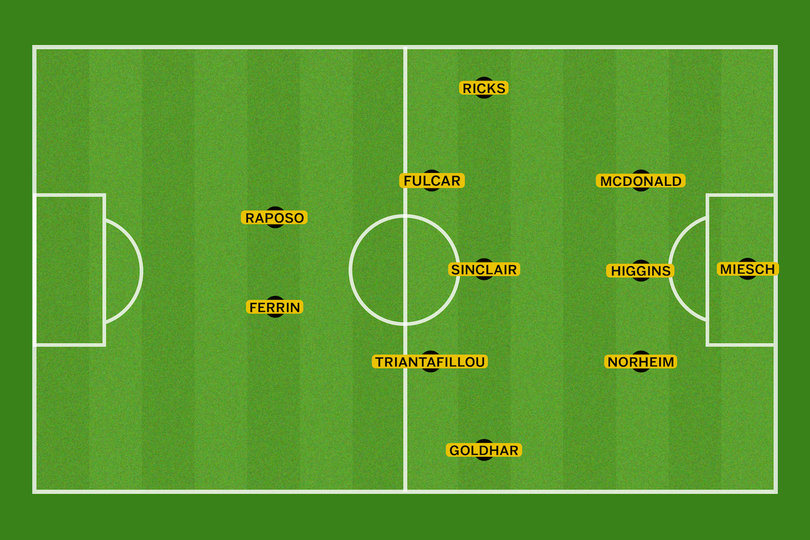The 3-5-2 is Syracuse’s identity, even if it doesn’t always work

The 3-5-2 is not commonly used in college soccer. But head coach Ian McIntyre has made it a staple of his style. Kevin Camelo | Co-Digital Editor
After Syracuse’s 7-4 loss to then-No. 8 Clemson on Oct. 19, head coach Ian McIntyre called the performance “embarrassing” and “unacceptable.” In his 10 years as the Orange’s head coach, he had never conceded seven in a game. Sondre Norheim had never seen that in his soccer career. Nyal Higgins said the Orange collectively “played like garbage.”
McIntyre didn’t blame his players, though. He blamed himself. The way he set up his players caused the Tigers offensive outpour, he said postgame. But McIntyre still set up his team the exact same way — in a 3-5-2 formation — a week later against then-No. 23 North Carolina State, leading to a shutout win.
The 3-5-2 has fluctuated as McIntyre’s go-to formation during his 10-year tenure at the helm of SU men’s soccer. But when he has the right players, he believes it’s crucial to Syracuse’s success.
“It gives us the ability to get good players high up the field,” McIntyre said. “I like the balance it provides with wing backs providing instant width, and it allows us to get pressure on the ball.”
Comprised of three central defenders and midfielders, two wing backs and two strikers, the system allows Syracuse (7-6-5, 2-4-2 Atlantic Coast) to press opponents in its attacking half. This season, it’s led to wins against then-No. 18 North Carolina and then-No. 23 North Carolina State, but also losses like against Clemson. When SU begins NCAA tournament play against Rhode Island on Thursday, it will likely set up this way to put its opponent under as much pressure as possible.
In McIntyre’s first three seasons as a head coach, the Orange played a 4-4-2 with a left and right back, two central midfielders, two wide midfielders and two strikers. In 2014, McIntyre employed the 3-5-2 because it better fit the team’s personnel. SU went 16-4-1 that year, tied for its highest win total in program history.
After that historic season, SU lost all three starting center backs — Jordan Murrell and Skylar Thomas graduated and Tyler Hilliard transferred to Duke. With the arrival of future MLS SuperDraft first-round picks, center backs Miles Robinson and Kamal Miller, in 2015, McIntyre reverted back to the 4-4-2. SU won 16 games again despite the change.
McIntyre said the optimal formation for a team changes based on its personnel, which has turnover from year to year.
“We’ve played (the 3-5-2) at different times for a number of years,” McIntyre said. “You put more strain on the three defenders instead of four, so it’s about being brave to know, at times, you’re going to be stretched and man-to-man in the back.”

Kevin Camelo | Co-Digital Editor
With the addition of players like Higgins, Amferney Sinclair and Noah Singelmann in 2019, McIntyre decided the 3-5-2 would be Syracuse’s primary formation. Higgins, a transfer from Oakland, has lined up alongside Sondre Norheim and Dylan McDonald in the back three, while Sinclair has started 15 of 18 games at center midfield.
“(McIntyre) really likes it because we can throw more numbers forward and put them under pressure,” said senior John-Austin Ricks. “He doesn’t really like to allow teams to pass the ball around the back and switch the side of the field.”
In SU’s 1-0 win over Colgate on Sept. 24, Massimo Ferrin scored the lone goal of the game when he pounced on a misplayed ball in the Raiders’ defensive half and was through on goal. If the Orange were sitting back in a different formation, Ferrin wouldn’t have been in a position to intercept it.
Ricks and Hilli Goldhar, SU’s wing backs, are both quick, good crossers and attack-minded when they get on the ball. In a formation where the role of the wing back is “at times, the most important,” McIntyre said, it’s essential to have the right players in those spots, or else the system won’t work. Ricks said the position needs to be “implanted in his head.”
“When we defend, they’re defenders. When we attack, they’re attackers,” McIntyre said about the wingbacks. “Those moments are very important, having those guys get forward when the time is right.”
Just as important as the wingbacks in the 3-5-2 are the center midfielders. When pressuring the opposing defense, two must drop back while the other goes forward. This year, the attacking midfielder has been Simon Triantafillou while Sinclair and Julio Fulcar have held a holding midfield role.
As the self-described “attack-minded” center midfielder, Triantafillou is responsible for occupying the space behind strikers Raposo and Ferrin. When pressing, he’s higher up the field than his other center midfielders. But if SU loses the ball in a dangerous area or the opponent breaks through its press, Triantafillou, along with the two wingbacks, must sprint back to prevent counter-attacks.
Triantafillou has been interchangeable when SU has briefly strayed away from the 3-5-2 this season. McIntyre switches to a back four when a starting center is unavailable. In the Orange’s first-round ACC tournament win over North Carolina, the junior started at left back in a 4-4-2 because Higgins was suspended due to a red card. In the season-opener against then-No. 13 Georgetown, Singelmann and Matt Orr started in a four-man backline with Norheim out injured.
But whenever he can, McIntyre has stuck to the system he knows SU plays best in. Whether it be its 1-0 win over Connecticut, a 7-4 disaster against Clemson or a season-defining win over NC State — all of which happened within a week and a half of each other — the 3-5-2 is the Orange’s identity because McIntyre believes in it.
“Ideally we’re looking to play to the strengths of our players and hide our weaknesses,” McIntyre said.




